Case 1: Magotan suddenly loses power failure
Failure phenomenon
A 2015 FAW Volkswagen Magotan 2.0TSI car is equipped with 02E type 6-gear Direct Shift transmission with a mileage of 30000km. The user reflects that everything is normal when the car runs cold, but after 2km, the vehicle will suddenly lose power, and at the same time, the gear display area on the dashboard becomes a red screen.
Fault Diagnosis
Maintenance personnel use fault diagnosis equipment to read the fault code, and the fault code prompts that the transmission oil temperature sensor G509 detects the high temperature. The 02E transmission is equipped with 3 temperature sensors. One of them is the working temperature sensor G509 of multiple wet double clutches. Its function is to prevent the clutch from overheating by monitoring the temperature of transmission oil at the outer edge of the clutch. It is integrated with the transmission input speed sensor G182, as shown in the following figure.
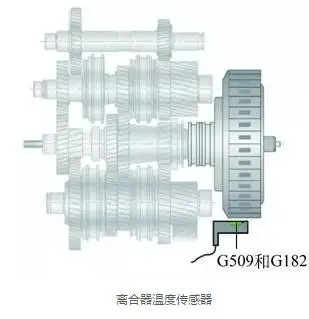
If the detected oil temperature exceeds 160℃, the transmission will enter the emergency mode. At this time, the engine will automatically reduce the output torque. At the same time, the transmission control unit will disengage the clutch, and the vehicle will lose power.
The other two temperature sensors are G93 and G510, as shown in the following figure, which are respectively used to detect the transmission oil temperature and the transmission control unit temperature. If either of the two sensors detects the temperature exceeding 145℃, the transmission will also enter emergency mode.
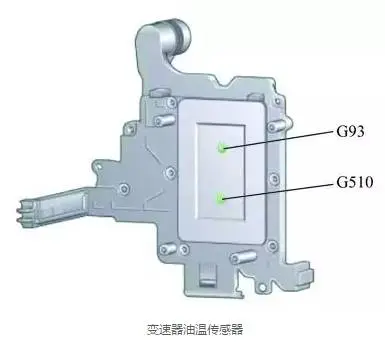
When a fault occurs in the road test, the data stream of the transmission is read. It can be seen from Zone 3 of 19 groups of data that the temperature data given by G509 is 165℃, which exceeds the limit, while the temperature of the other two sensors is only 50℃. This result is very abnormal. One is that the road test distance is short, and there has never been a fierce driving action during this period. The other is that the transmission has not experienced obvious skid phenomenon. Why does G509 give such a high temperature? Moreover, G509 directly measures the oil temperature of the transmission. The oil circulates inside the transmission. According to the law of heat conduction, the oil temperature at G509 and G93 should not have such a large temperature difference. It is assumed that the G509 output signal is more likely to be faulty.
Troubleshooting
Replace the sensor assembly integrated with G509 and G182 for troubleshooting.
Case 2: Volkswagen 02E DSG automatic transmission failure
Failure phenomenon
A 2015 FAW Volkswagen Magotan car, equipped with a 5L engine, is equipped with a 02E DQ250 type 6 gear/self-integrated DSG dual clutch control transmission.
The car occasionally has no reverse gear, and the forward gear is not very normal. At the same time, the gear display light in the vehicle instrument will light up and flash continuously. As shown in the following figure, the failure phenomenon disappears after the engine is turned off and restarted again, and not often.

Fault Diagnosis
First, connect diagnosis equipment to read its fault memory, and the result reads P2271 fault code, which is a mechanical disconnection fault. After clearing the fault code, it is difficult to reproduce the fault. However, in the subsequent repeated related tests, we did master the rules of failure, but the fault codes recorded by the system have changed, this not only obtains the law of fault appearance, but also obtains the real fault phenomenon.
The real failure phenomenon is that there is a slight delay when entering and entering the Forward Block. After the D/N block is removed, shifting fork cannot return to the position quickly, and completely retreat to the N position for 4 consecutive times (loud noise). Once the second situation occurs, trouble light lights up and stores the fault content.
The fault code recorded in the fault memory is P2271 mechanical disconnection fault; 19143 gear mechanical disconnection without signal/communication, as shown in the following figure.
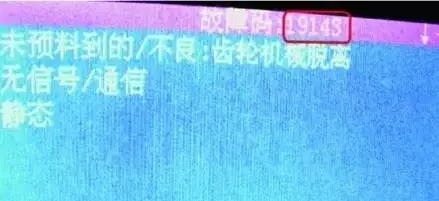
Use diagnosis equipment again to read relevant dynamic data information to determine the occurrence of abnormal data when the fault occurs and determine the cause of the fault.
When reading dynamic data, we should combine the characteristics of actual fault phenomena and pay attention to observing the fluctuation of key data information to lock the fault location. In this way, the target is locked in the 02-08-006 group of data contents among many dynamic data contents, because this group of data contents reflects the very critical control current of K1 clutch control solenoid valve N215, k1 clutch safety protection control the action of solenoid valve N233 and the most important control current of the transmission main oil pressure adjustment control solenoid valve N217.
First, record the normal standard data:
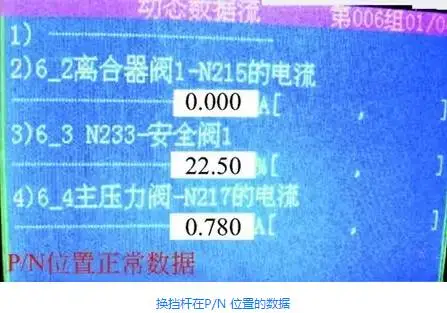
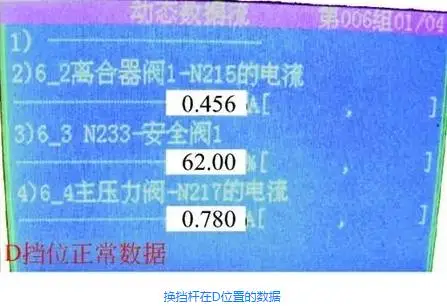
Then, the fault data when the fault occurs is also recorded. As shown in the following figure, once the fault occurs, the transmission enters the fault mode again, at this time, the reverse gear cannot be driven and the gear indicator light in the instrument is on and flashing again. Through the comparison of data, combined with the fault phenomenon (D/N gear back process), it is not difficult to see that the problem is not in the control function of the clutch, but in the shifting fork switching control.
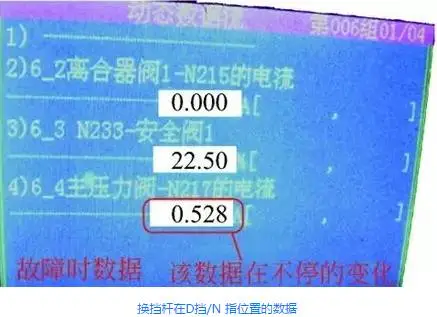
The fault analysis is carried out again. Through the changes of various data in 006 groups of data streams, it can be seen that when the shift lever is switched from D gear/N, the control unit cuts off the engine power flow through N215 solenoid valve, the clutch is completely disconnected (even if two gears are formed inside the transmission at this time, there is no problem), n233 safety protection solenoid valve only monitors the change of K1 clutch real pressure timely according to the control unit through G193 clutch pressure sensor to prepare for safety cut-off in time, at this time, the system pressure controlled by N217 is unchanged, but at the same time, the synchronizer of the 1-gear/3-gear shifting fork inside the transmission after the shift lever is driven by D-gear/N-gear, it needs to be switched to the neutral position.
Due to the special switching control of this transmission shifting fork (as shown in the following figure):
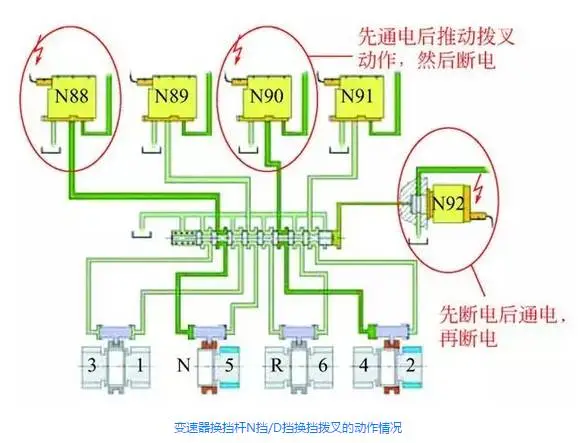
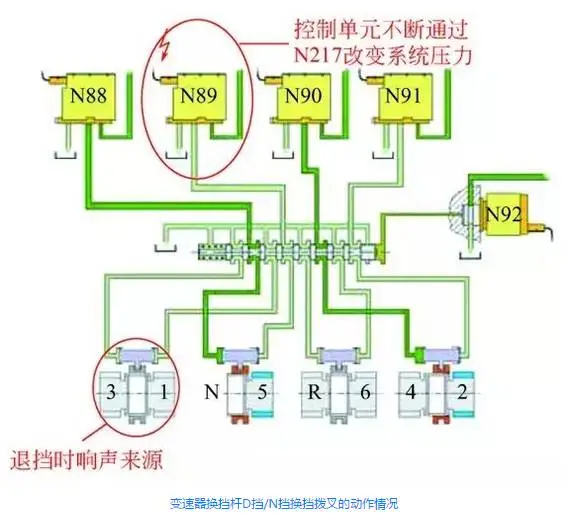
For example, after the shift lever is blocked by N gear/D gear, in addition to the front K1 clutch ready for power transmission, the shifting fork action inside the transmission is when the total multi-way shift solenoid valve N92 is not powered on, after the N88 solenoid valve is instantly powered on, switch the 1-gear/3-gear synchronizer shifting fork to the 1-gear side, then N88 switches to the no-power state, and then N92 solenoid valve switches to power-up state from the power-off state. At the same time, n90 solenoid valve is also switched from the original power-off state to power-up state, the purpose is to switch the 2-gear/4-gear synchronizer shifting fork to the 2-gear side.
Then, N92 and N90 switch to no electricity, at this time the two synchronizer shifting forks are locked on the corresponding gear by mechanical steel balls. At this time, two gear positions are formed inside the transmission (two gear positions are controlled by two clutches respectively), one gear is used as the starting gear, and the second gear is used as a preparation gear. In this way, through the fault phenomenon and the action principle of shift synchronizer, it is clearly known that the fault location and noise are caused by the movement of 1 gear/3 gear synchronizer to N position, then the control unit uses its internal displacement sensor to determine the exact position of shift shifting fork (shifting fork) by sensing the electromagnet above the synchronizer. Therefore, within the specified time, the first gear/third gear synchronizer is not switched to its real position by hydraulic pressure. At this time, the control unit will set the fault code and start the safety protection control.
Troubleshooting
After finding the possibility of failure caused by clutch control, according to the above analysis, it is shown that the location of 1 gear/3 gear shifting fork is the main cause of failure. Generally speaking, the possibility of changing gear synchronizer itself is extremely low, therefore, it is very likely that the system pressure problem causes problems in the action of shifting fork. Therefore, the problem can be solved by replacing the electronic hydraulic control unit. Finally, replace the new electronic hydraulic control unit and carry out relevant matching to completely eliminate the faults.
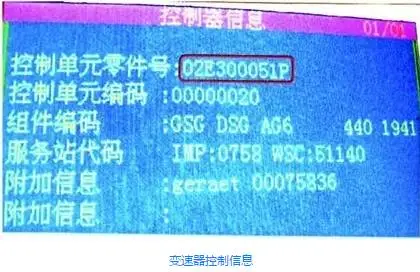
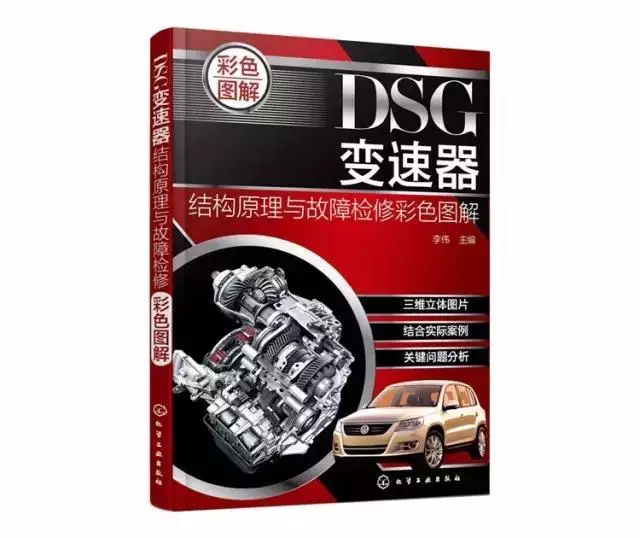
The above content is selected from the color diagram of DSG transmission structure principle and fault repair
Author: Li Wei, pricing: 58.0 yuan
Dangdang, Jingdong, Amazon, and Tmall stores all sell
>> This book uses a large number of color three-dimensional pictures to introduce the characteristics, structure, principle, overhaul and matching of DSG dual clutch automatic transmission of the new Volkswagen 02E and 0AM, this paper analyzes in detail the structural principles of Automatic Transmission Machinery, hydraulic pressure, electric control and other systems of double clutch, and explains the oil circuit, disassembly and assembly, maintenance process and other aspects of DSG, finally, combining with practical cases, the paper introduces the fault maintenance method of dual clutch automatic transmission.